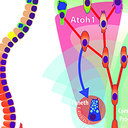Improved in Vivo Targeting Capability and Pharmacokinetics of 99mTc-Labeled isoDGR by Dimerization and Albumin-Binding for Glioma Imaging.
Sleutelwoorden
Abstract
Previously, we successfully developed the c(phg-isoDGRk) peptide as a novel integrin α5β1-targeted SPECT imaging probe 99mTc-HisoDGR for Glioma imaging. However, the fast clearance of 99mTc-HisoDGR in blood reduced its tumor accumulation and retention, which would be the obstacles for further clinical application. Dimerization and albumin-binding strategies have been proven as effective approaches to improve tumor targeting capability and blood circulation time of radiotracers. In this study, the novel PEGylated dimeric isoDGR peptides (termed 3PisoDGR2) and its analogue with an albumin binder (termed AB-3PisoDGR2) were designed, and the corresponding radiotracers 99mTc-3PisoDGR2 and 99mTc-AB-3PisoDGR2 were fabricated and assessed for tumor-targeting and in vivo pharmacokinetics properties in subcutaneous and orthotopic tumor models. The dimerization of isoDGR peptide provided higher binding affinity to tumor cells and longer blood circulation time than the original monomeric isoDGR peptide, resulting in twice increased tumor uptake (99mTc-3PisoDGR2 2.51 ± 0.17 %ID/g vs 99mTc-PisoDGR 1.17 ± 0.21 %ID/g, P < 0.01) at 0.5 h post-injection (p.i.) and enhanced tumor to nontargeting tissue ratios (T/NT) in most normal organs. The blocking study indicated that the tumor uptake was receptor-mediated specifically. NanoScanSPECT/CT imaging of 99mTc-3PisoDGR2 in glioma tumor-bearing model showed clear visions of tumors with low background, except high uptake in excretion system including kidneys and bladder at all detected time points (0.5, 1, and 2 h p.i.). The orthotopic glioma tumor could also be clearly visualized by nanoScanSPECT/CT imaging with 99mTc-3PisoDGR2. The addition of albumin-binding entity further prolonged blood circulation time and reached higher tumor uptake for 99mTc-AB-3PisoDGR2. However, since 99mTc-AB-3PisoDGR2 is less capable of passing BBB than 99mTc-3PisoDGR2, 99mTc-3PisoDGR2 is preferable for the in situ glioma imaging. In conclusion, 99mTc-3PisoDGR2 represents an improved molecular probe for integrin α5β1-targeted tumor imaging, showing more potential for further clinical application.



